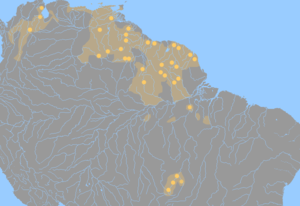Cariban language
| Cariban | |
|---|---|
| Geographic distribution: |
Mostly within north-central South America, with extensions in the southern Caribbean and in Central America. |
| Linguistic classification: |
Je–Tupi–Carib?
|
| Glottolog: | cari1283 |

Present location of Cariban languages, c. 2000, and probable extent in the 16th century.
|
|
The Cariban languages are an indigenous language family of South America. They are widespread across northernmost South America, from the mouth of the Amazon River to the Colombian Andes, but also appear in central Brazil. Cariban languages are relatively closely related, and number two to three dozen, depending on what is considered a dialect. Most are still spoken, though often by only a few hundred speakers; the only one with more than a few thousand is Macushi, with 30,000. The Cariban family is well known in the linguistic world partly because Hixkaryana has a default object–verb–subject word order, previously thought not to exist in human language.
Some years prior to the arrival of the first Spanish explorers, Caribs invaded and occupied the Lesser Antilles, killing, displacing or assimilating the Arawaks who inhabited the islands. The resulting language was Carib in name but largely Arawak in substance. This was due to invading Carib men killing Arawak men and taking Arawak wives, who then passed their language on to the children. For a time, Arawak was spoken by women and children and Carib by adult men, but the situation was unstable. As each generation of Carib-Arawak boys reached adulthood, they acquired less Carib, until only basic vocabulary and a few grammatical elements were left. This "Island Carib" became extinct in the Lesser Antilles in the 1920s, but survives in the form of Garífuna, or "Black Carib", in Central America. The gender distinction has dwindled to only a handful of words. Dominica is the only island in the eastern Caribbean to retain some of its pre-Columbian population—the Carib Indians—about 3,000 of whom live on the island's east coast.
...
Wikipedia
